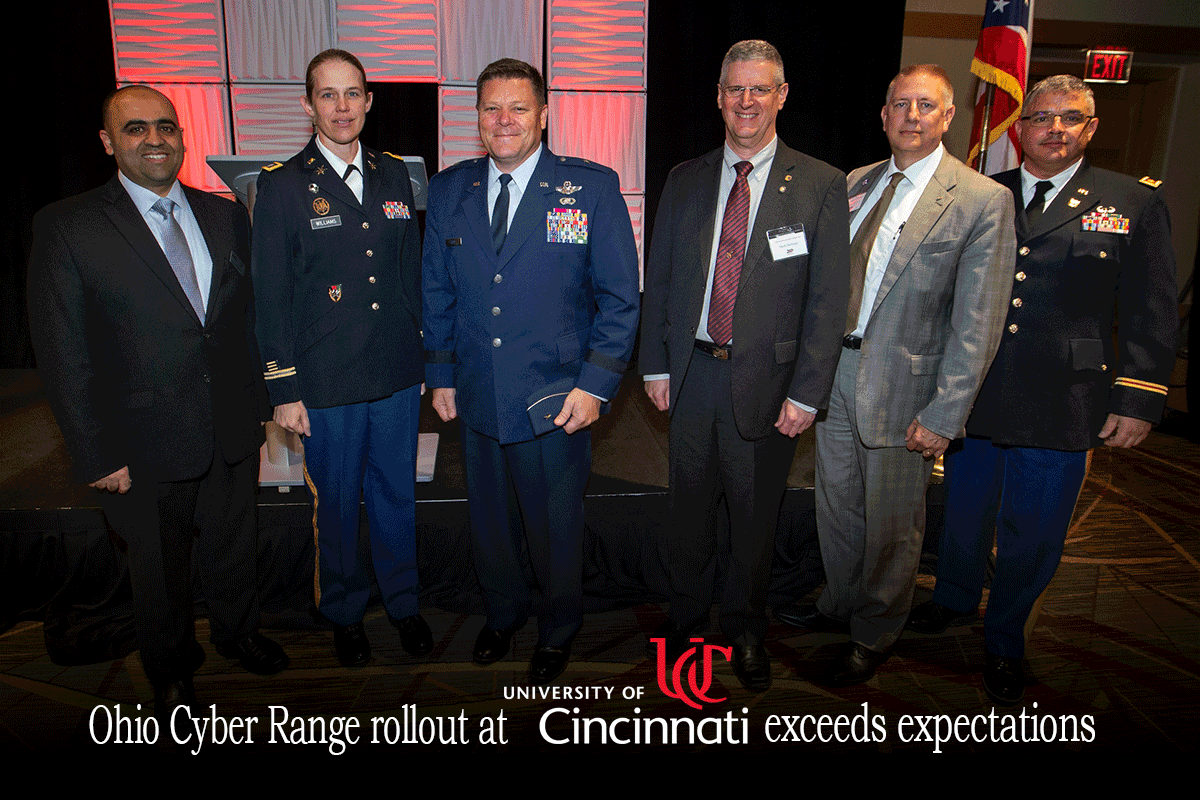Ohio Cyber Range rollout at University of Cincinnati exceeds expectations
Story by Matt Koesters, University of Cincinnati
CINCINNATI, Ohio (06/19/19)
Cyber protection is one of the main lines of defense in modern military operations, according to Brig. Gen. James Camp, Ohio assistant adjutant general for Air. But he sees cyberattacks by actors foreign and domestic alike as threats that the military simply can no longer handle on its own.
“This is the first threat that doesn’t just involve law enforcement, our military or our border patrol,” Camp said. “This is a society issue.”
Camp and other officials from the Ohio Adjutant General’s Department and the Ohio Department of Higher Education, K-12 teachers, students and industry leaders joined University of Cincinnati faculty and staff members on June 19 for the university’s inaugural Cybersecurity Education Symposium to celebrate the completion of the second phase of the rollout of the Ohio Cyber Range (OCR).
UC served as the demonstration site for the OCR, which is based on the College of Education, Criminal Justice and Human Services’ Sandbox virtual cloud computing environment. But it took a village to make the OCR a reality, said Professor Hazem Said, director of the UC School of Information Technology.
“Within the university, we broke silos, removed barriers and came together as staff, educators, researchers, administrators and students from multiple colleges and units to make it happen,” explained Said, who expressed gratitude to his colleagues, Professor Mark Cahay with the College of Engineering and Applied Sciences and Professor Richard Harknett with the McMicken College of Arts and Sciences, for their contributions to the OCR.
“At the University of Cincinnati, we are very much about collaboration and partnership,” UC Provost Kristi Nelson said. The OCR exemplifies UC’s Next Lives Here strategic direction, Nelson said, and is an example of UC unleashing its vision to lead public, urban universities into a new era of innovation and impact.
The outcomes of the OCR’s second phase met — and often exceeded — expectations, said Charles See, vice chancellor of external relations and education technology with the Ohio Department of Higher Education. “At the state level, we think of the Ohio Cyber Range as a very big deal,” he said.
See explained the future prosperity of the state is tied to the success of the OCR because of the state’s current and future cybersecurity needs. “None of this could have happened without the partnership with the University of Cincinnati,” See said. “They really stepped up.”
The third phase of the OCR rollout will see the power of the computing system at UC doubled and an identical system installed at the University of Akron, according to Mark Bell, cybersecurity outreach coordinator with the Ohio Adjutant General’s Department. With those pieces in place, the OCR will be able to serve every high school and university in the state, Bell said. The third phase will also see the establishment of between 12 and 15 programming centers throughout Ohio, where students will work alongside industry professionals and educators. Bell said he is hopeful that making the OCR more accessible will generate more interest in cybersecurity education and bolster the state’s IT talent pipeline.
Early indications suggest it’s already doing just that. The Cybersecurity Education Symposium included presentations by veterans, high school students and teachers, information technology professionals and others who had already worked within the OCR. “The OCR is an absolutely critical piece to offering technology classes at my high school,” said Marla Norman, a teacher at Lebanon High School in Lebanon, Ohio.
Corporate cybersecurity departments are often reluctant to bring on college students for cooperative education rotations because of their lack of experience, said Alex Kloft, head of cybersecurity with the Cincinnati Insurance Companies. Kloft mentored four UC students in a grant-funded co-op program piloted by the Division of Experience-Based Learning and Career Education, and said the OCR gave the students the tools and freedom they needed to succeed in a professional setting. “The OCR provides multiple benefits to industry partners,” he said. “You have a pool of students that are eager to help and learn. You can guide them and grow them into what you need them to be.”
